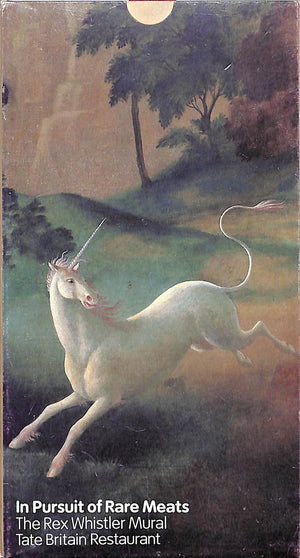"In Pursuit Of Rare Meats: The Rex Whistler Mural- Tate Britain Restaurant" 2003
$450
10-fold mural laid-in
Tate Publishing
2003
First Edition
7 1/2" x 4 1/4"
7 1/2"H x 39"W (open)
Fine
The Expedition in Pursuit of Rare Meats is a mural by the English painter Rex Whistler (1905–1944), commissioned in 1926 and completed in 1927 at the Tate Gallery (now Tate Britain) in London. The mural was commissioned by the gallery's inaugural director, Charles Aitken, for the re-opening of its restaurant, where to this day it forms the entire interior surround of what is now the eponymously named eatery, "The Rex Whistler Restaurant".
The work has been at the centre of controversy in recent years over the artist's depiction, in one scene, of a black child chained to and running behind a horse and cart and, in another, of Chinese people deemed by some to read as stereotypical as the figures are "caricatured". The entire painting, and its background story, can also be read as a satire on imperialism ("Rare Meats" being a culinary term for lightly-cooked meat, while the painting goes to extremes to find food that is "rare" in the sense of being difficult to find).
History
A 1927 pamphlet for Rex Whistler Room at the Tate Gallery
The mural was commissioned in 1926 and completed in 1927. Aitken had hoped that the high profile of the mural's commission would induce large restaurateurs like J. Lyons and Co. to fund murals in their establishments. It was funded by Joseph Duveen, who had previously funded the mosaics created by Boris Anrep for the entrance to the Tate in 1921. Duveen had suggested the creation of a refreshment room at the Tate in 1925, and had offered £500 (equivalent to £28,728 in 2019) towards its decoration with a mural. Rex Whistler was recommended for the job by Henry Tonks, who was part of the committee that chose the artist for the mural. Whistler was chosen for the project in 1926 while he was still a student at the Slade School of Art. Another member of the committee, Philip Sassoon, had favoured the artist Glyn Jones, and proposed a competition for the mural's design among alumni of the British School at Rome.
Whistler was paid £5 a day (equivalent to £292 in 2019) over the 18 months it took to complete the work, and given a £100 bonus upon the work's completion (equivalent to £6,013 in 2019). His assistant, Nan West, was paid £3 per day. West's role was to mix colours and prepare Whistler's designs to be transferred to the large canvas. The mural was submerged during the flooding of the River Thames in January 1928 but was undamaged. The Expedition in Pursuit of Rare Meats was included in the Tate's 1939 exhibition Mural Painting in Great Britain, 1919 to 1939, which ran from May to June 1939.
The mural was restored in 2013 as part of a £45 million refurbishment of Tate Britain.
Design
The action depicted in the mural takes place in the fictive land of "Epicurania" ruled over by the "Duke of Epicurania". The content of the mural was created in a collaboration between Whistler and the novelist Edith Olivier. The story articulated in the work depicts an account wherein an "expedition" of a group of seven people departs in search of exotic meats. They travel on all manner of transport—bicycles, carts and horses—from their point of departure the "Duchy of Epicurania", and venture through bizarre and enchanting lands while coming upon creatures such as unicorns, truffle dogs and two giant gluttons guarding the entrance to a cave. The tale finishes with the adventurers arriving back to an ebullient welcome, and the menu of the Epicuranians, which had previously consisted of dry biscuits, is forever changed." Several notable British buildings are depicted in the mural including the bridge at Wilton Park and an arch and pavilion in the grounds of Stowe House. Henry Tonks is portrayed in a bust that looks out from a grotto in the mural.
The mural depicts the "enslavement of a black child and the distress of his mother" and later shows the child "running behind a horse and cart which he is attached to by a chain around his neck". The depicted figures are a few inches high, and would have been conspicuous to only a few diners.

















